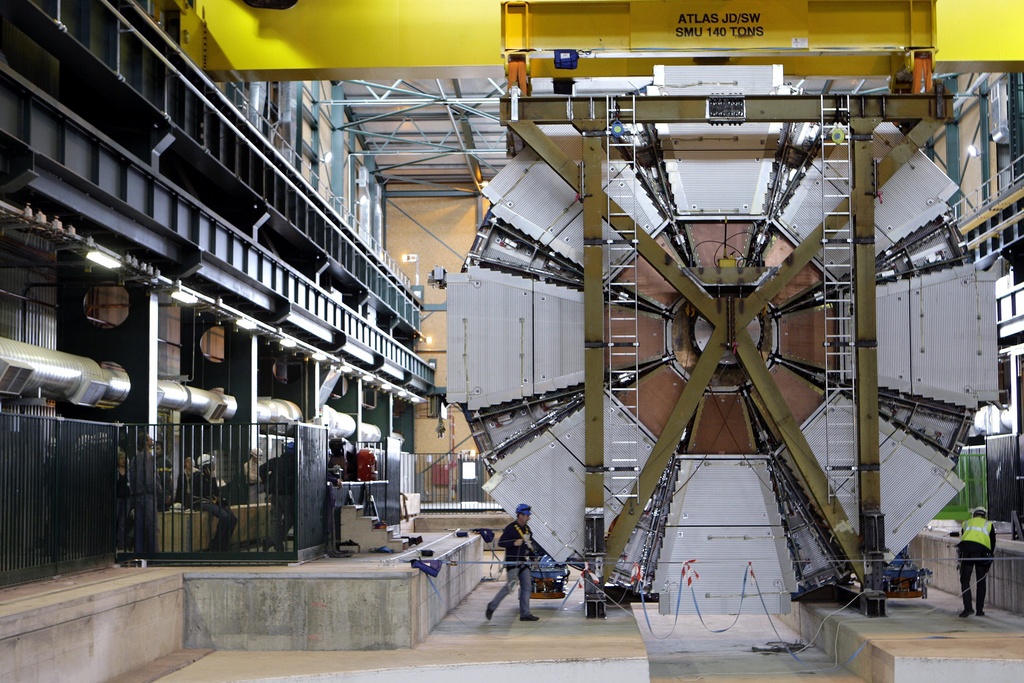Cern study gives insight into cloud formation

Are cosmic rays from deep space and the Sun responsible for creating clouds in the Earth’s atmosphere and changing the climate?
Scientists working on this issue at the European Organization for Nuclear Research (Cern) in Geneva have presented initial results suggesting cosmic rays have an effect on cloud formation but found no proof they drive climate change.
The preliminary findings of the Cosmics Leaving Outdoor Droplets (CLOUD) experiment, published in Nature journal on Wednesday, show that a few kilometres up in the atmosphere cosmic rays cause a ten-fold increase in the formation rate of tiny aerosol particles.
But these are still far too small to create clouds.
Urs Baltensperger, head of atmospheric chemistry at the Paul Scherrer Institut in Villigen, Switzerland, who was part of the research team, said the results were an important first step.
But it was premature to conclude that cosmic rays had a significant influence on cloud formation and the climate: “Anyone who believes that we see an enhancement of clouds through cosmic rays is moving too fast,” he told swissinfo.ch.
The international team of scientists from 18 institutes found that while cosmic rays “significantly enhanced” the formation of aerosol particles in the mid-troposphere and above, which could grow into the seeds for clouds, in the lower atmosphere additional vapours such as ammonia are required.
The research also revealed that the chemicals believed to seed clouds – sulphuric acid, water and ammonia – even with cosmic ray enhancement are not sufficient to explain atmospheric observations of aerosol formation. Additional vapours of organic or human origin may play a far more important role in cloud formation than suspected.
Clouds are important for regulating global temperatures as they reflect part of the sun’s heat back into space. But the formation of aerosols that seed clouds is not well understood and is a source of uncertainty in climate models.
Long-running debate
There has been a long-running debate over the possible role of cosmic rays in the creation of aerosols. In the 1990s Danish researchers first suggested that cosmic rays generated by exploding stars known as supernovas help generate low-altitude clouds.
The number of cosmic rays that hit the Earth is lower when the Sun’s activity is high. It has also been suggested that reduced cosmic rays may lead to reduced cloud formation, causing global temperatures to rise. Some climate change sceptics say this process, rather than the burning of fossil fuels, can explain much of the Earth’s recent rise in temperature.
At Cern a custom-built ultra-clean stainless steel chamber filled with highly purified air, water vapour, sulphur dioxide, ozone and ammonia was used to recreate the Earth’s atmosphere.
The researchers bombarded the chamber with a beam of proton particles from the Cern’s Proton Synchrotron accelerator to provide a source of artificial cosmic rays.
By controlling the chamber’s temperature and pressure, they reproduced conditions found at different altitudes and latitudes, and were able to sample the artificial atmosphere to see what effect the rays were having.
Reactions
Scientists welcomed the results but gave different conclusions.
“Of course there are many things to explore, but I think the cosmic-ray/cloud-seeding hypothesis is converging with reality,” Henrik Svensmark, a physicist at the Technical University of Denmark in Copenhagen, who claims a link between climate change and cosmic rays, told Nature.
Mike Lockwood, a space and environmental physicist at the University of Reading in England, said small particles may not grow fast enough or large enough to be important in comparison with other cloud-forming processes in the atmosphere.
Piers Forster, a climatologist at the University of Leeds, who studied the link between cosmic rays and climate for the latest scientific assessment by the International Panel on Climate Change, said it would be wrong to conclude that cosmic rays were a major driver of climate change.
The study confirms that cosmic rays can help produce aerosol particles, but also shows they do not contribute much in the lower atmosphere, he told Reuters.
“This makes it extremely unlikely that they can affect low clouds anywhere other than cold and pristine marine environments,” he added.
Urs Neu from the Swiss Forum for Climate and Global Change agreed.
“All the evidence we have points in the direction that it seems unlikely [cosmic rays] have a significant influence,” he told swissinfo.ch.
The group plan to continue their experiments over the next five to ten years with more, complex components and larger particles in the chamber, and they hope eventually to generate artificial clouds for study.
The Cosmics Leaving Outdoor Droplets (CLOUD) project involves an interdisciplinary team from 18 institutes and 9 countries in Europe and the United States.
These institutions include Switzerland’s Paul Scherrer Institute, the California Institute of Technology and Germany’s Max-Planck Institutes.
The experiment, which has been running since the end of 2009, brings together atmospheric physicists, solar physicists, and cosmic ray and particle physicists.
It is also the first time a high energy physics accelerator has been used for atmospheric and climate science.
Cern was founded in 1954 by 12 states, including Switzerland, and now has 20 member states.
Around 6,500 scientists – roughly half the planet’s particle physicists – from around 500 institutes and universities have access to Cern.
Cern built the Large Hadron Collider (LHC), the world’s most powerful particle accelerator, which was launched in September 2008. In the LHC, which cost $10 billion, high-energy protons in two counter-rotating beams are smashed together to search for exotic particles.
The World Wide Web began as a Cern project called Enquire, initiated by British expert Sir Tim Berners-Lee in 1989.

In compliance with the JTI standards
More: SWI swissinfo.ch certified by the Journalism Trust Initiative















You can find an overview of ongoing debates with our journalists here . Please join us!
If you want to start a conversation about a topic raised in this article or want to report factual errors, email us at english@swissinfo.ch.